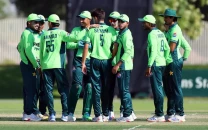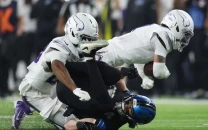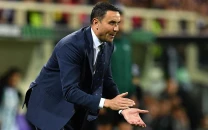Copa America ’15 – a shadow of the continent’s attacking talent
out of the 12 teams that play in the Copa, two of them are guests — Mexico and Jamaica this year

Chile won the Copa America for the first time on Saturday when a cheeky penalty from Alexis Sanchez clinched a shootout victory over Argentina in front of their own fans. PHOTO: AFP
Ninety-nine years and 44 editions of familiarity breeding rivalry, of players stepping on a pitch both strengthened and burdened by Copa America’s past. The competition is supposed to be the best of what the South American continent has to offer in terms of football; incredible technical ability, flashy play, intensity, cynicism, and more than anything else, players with unmatched attacking prowess. But was this edition in Chile a reflection of this? Perhaps 60-40 in favour of probably not.
Arsenal manager Arsene Wenger said last year, “If we look across Europe and the world of football, then South America is the only continent to develop strikers today.” And that is where the beauty of the Copa America — the oldest continental competition in history — is supposed to lie in.
The strikers grow up playing football on the crowded streets of Rio, Buenos Aires and Santiago. And there, negotiating their way through the narrow spaces with the ball at their feet, they learn to control the ball better than any academy in Europe.
The Copa may pale in comparison to the European Championships when it comes to popularity — indeed it was once considered a second-grade competition by South America’s two biggest nations Brazil and Argentina. But with recent disappointments in the World Cup and the strength of the other teams, that was no longer the case this time around.
It therefore comes as no surprise that in comparison with the Euros in terms of attacking display, the Copa gives as good as it gets. A total of 76 goals were scored in 31 matches in Euro 2012, while 59 were scored in 25 Copa matches this year; leading to similar goals per match ratios.
However, out of the 12 teams that play in the Copa, two of them are guests — Mexico and Jamaica this year — while the Euro has 16 sides from the continent itself. Jamaica failed to find the net in the tournament — losing all three matches 1-0 — while Mexico also struggled in front of goal, with their attack only coming alive in the entertaining 3-3 draw against eventual winners Chile.
The sides often ended up cancelling each other out, especially since South American teams are so familiar with each other. For instance, when Chile faced Uruguay in the quarter-finals, it was the seventh meeting between the two sides in the past 10 years, whereas in the same span, Spain have played Germany just thrice. So when the sides meet in Copa, they know a lot about their opponents, making it just that bit easier to nullify the attacks.
The South American attackers did prove more prolific during the latter part of the tournament, with 12 goals in the quarter-finals and semi-finals during the Euros as compared to 17 in Copa.
However, South America’s famous number nines failed to ignite the tournament this time around. The highest profile ones such as Radamel Falcao, Edinson Cavani and Gonzalo Higuain all had disappointingly underwhelming tournaments by their usual high standards. Instead it was the high profile number tens such as Lionel Messi that shone more in the tournament. The same was the case during the World Cup, where Colombian number ten James Rodriguez won the golden boot and Messi the golden ball.
South America’s monopoly, it seems, lies not only with the best number nines but also with the number tens.
Europe’s best South Americans fail to ignite Copa
A look around the biggest clubs in Europe will show a great number of the biggest clubs being led by South American talent. Arsenal have Alexis Sanchez, Manchester United have Angel di Maria and Falcao, Chelsea have Willian, Oscar and Diego Costa (who decided to play for Spain instead of Brazil), Juventus have Carlos Tevez, Real Madrid have Rodriguez, PSG have Cavani, and of course European champions Barcelona are led by their famous MSN trio of Messi, Luis Suarez and Neymar.
However, few of these big names lived up the expectations levied on them when the tournament kicked off in Chile. Messi was the standout player of the lot, winning the man of the match award thrice and providing the most assists in the tournament. However, considering he just scored 53 goals in 51 games for Barcelona, his return of one goal in six games — that too from the spot — was surely less than what Tata Martino would have been counting on.
The other two members of the famous MSN were serving suspensions — Suarez didn’t feature in the entire tournament for his bite on Giorgio Chiellini in the World Cup, while Neymar was sent off against Colombia and slapped with a ban that ended his tournament — ending Brazil’s hope along with that.
Former Juventus star Tevez came on as a substitute twice but did little, and Cavani and Falcao seemed like shadows of their once deadly selves.
Sanchez set the Premier League alight for Arsenal but moments of brilliance like his stunner in the FA Cup were sorely missing for Chile until his outrageous winning panenka penalty which won Chile the tournament.
Others step up to the plate
But when Copa’s main lineup of stars failed to shine, a collective display picked up the slack. That’s Copa America for you.
Paulo Guerrero and Eduardo Vargas top-scored with four goals in this edition. Neither of the two have had stellar club careers but both perform superbly when donning on the Peru and Chile shirt.
Argentina’s Higuain, Paraguay’s Lucas Barrios, Ecuador’s Miller Bolanos and Bolivia’s Marcelo Moreno were all chipped in with two goals but only the Napoli forward can claim to be a household name.
And so while the Copa failed to showcase the best players South America has to offer, it certainly managed to highlight the strength in attacking depth that the continent has, with even relatively unknown players shining for their sides. Europe, perhaps, can take a page out of their book.
Published in The Express Tribune, July 6th, 2015.
Like Sports on Facebook, follow @ETribuneSports on Twitter to stay informed and join in the conversation.



















COMMENTS
Comments are moderated and generally will be posted if they are on-topic and not abusive.
For more information, please see our Comments FAQ